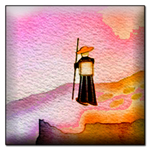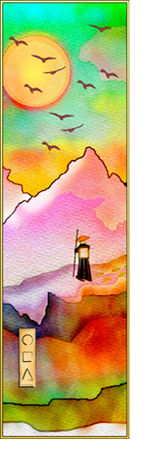On The Way: The Daily Zen Journal
Great Enlightenment pt 2
Dogen (1200-1253)

Great Master Rinzai said: “In the great Tang Dynasty you could not find any unenlightened people no matter how hard you tried.”
Since Rinzai transmitted the true Buddhist Way there is no reason to doubt his statement. If we examine his saying closely we will see that “Tang Dynasty” does not refer to any particular era or place.
It is the country of our own body and mind, so do not think that enlightenment is found in just one place. That is why he said it was so difficult to find an unenlightened person in the Tang Dynasty. He meant that our real self, both in the past and present, is the enlightened self.
“Throughout history all the woodcutters in the mountains and fishermen in the seas have had enlightenment.” If students study Rinzai’s words they will not be wasting their time. However, we should also study the teachings of other patriarchs.
Let us question Rinzai: “If you only think that it is difficult to find unenlightened people, that is not good enough. You should also realize that it is just as difficult to find enlightened people. In addition, you should know that there are half-enlightened people with wonderful and bright appearances. You have never seen such a person, have you?”

Even though it may be true that it was difficult to find unenlightened people in the Tang Dynasty, do not make it the standard of your study. Rather, seek to find several great dynasties within just one half-enlightened person. Is this easy or difficult to understand? If you are able to comprehend this point you can be said to be a buddha or patriarch with real practice.

Do not think, as most people do, that if one has Great Enlightenment and becomes a buddha, you are different from ordinary people, or that Great Enlightenment causes bodhisattvas to return to the world and try to save others. In our present study we are not concerned with the difference between enlightenment or illusion, or buddhas and ordinary people. Here, Great Enlightenment is even different from the Great Awakening of a bodhisattva.
Great Enlightenment is without beginning or end, and so is illusion. Great Enlightenment is not external, and there is no illusion to obstruct it. Great Enlightenment contains illusion and is not concerned with large or small. Great Enlightenment is its own Great Enlightenment; it is snow-covered mountains, rocks, and trees.

The Great Enlightenment of buddhas is for sentient beings, and the Great Enlightenment of sentient beings illuminates the Great Enlightenment of the buddhas. There is no distinction between them. Great Enlightenment is not just the function of ourselves or others. It fills everywhere and is the center of existence in both the form of enlightenment and illusion. Illusion can only seek Great Enlightenment and we can never find Great Enlightenment outside of illusion.

Delivered to the monks January 20, 1243 by Dogen
Excerpted from Shobogenzo Volume 1 – translated by Kosen Nishiyama and John Stevens 1975 – out of print and no longer available





The first part of Great Enlightenment from July 2013 deserves a fresh reading. Also, the beginning of that commentary from then appears here and now:
“You must be completely detached from the notion of Great Enlightenment and never seek or crave it.”
The lovely paradox of right intention in practice….who is not mystified by Great Enlightenment? And yet we are advised, the more we seek it, the more illusive it becomes. So, out of the corner of our consciousness we peek from time to time, wondering, even so, where, exactly, and when is this Great Enlightenment? The maxim we hear in practice “Great effort, no goal” approximates the attitude of right intention. What a generous discourse on Great Enlightenment Dogen shares with us!
From the current selection we read Rinzai’s words: “In the great Tang Dynasty you could not find any unenlightened people no matter how hard you tried,” followed by Dogen’s interpretation of that statement. What is most interesting in what follows is Dogen’s encouragement to
“Let us question Rinzai: If you only think that it is difficult to find unenlightened people that is not good enough. You should also realize that it is just as difficult to find enlightened people.”
In this we see the invitation to question not only ourselves in practice, but also to question even well known authorities in Zen. Keeping one’s lights on during practice is quite a challenge. While we trust the Way itself, the interpretation is coming through the teachers from the past and present, each of whom can have their own blind spots.
As we continue with the reading we return to dropping all our notions of Great Enlightenment. The paradox of “understanding” once again gets in the way. Continually letting go of anywhere to rest or any attainment is at least a safe raft to embark on.
Journeying forward with you,
Elana, Scribe for Daily Zen